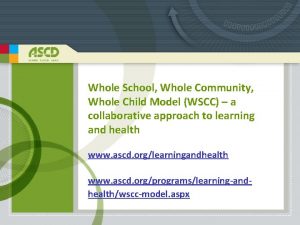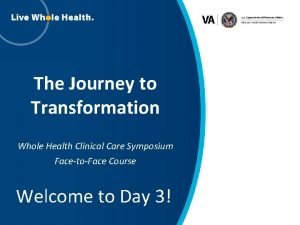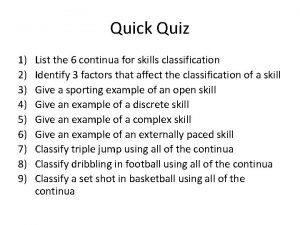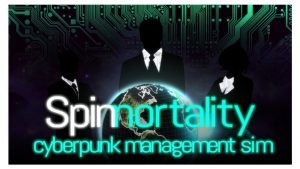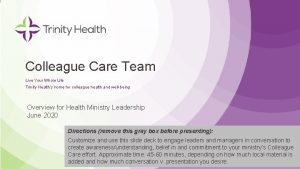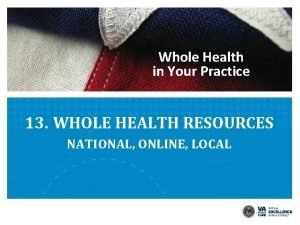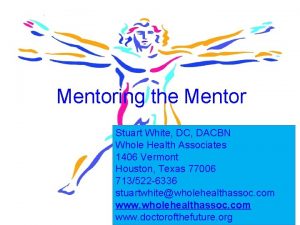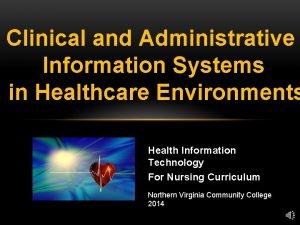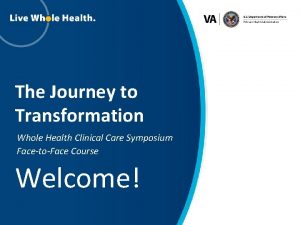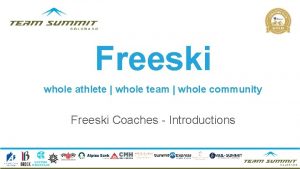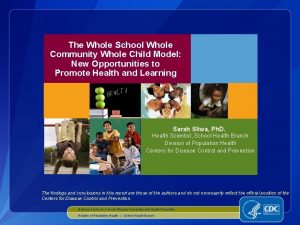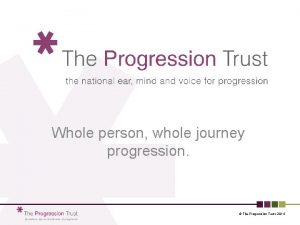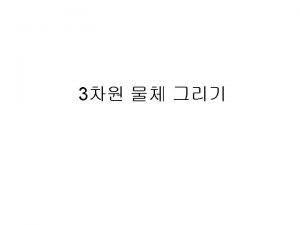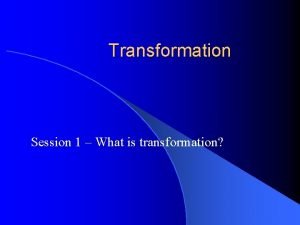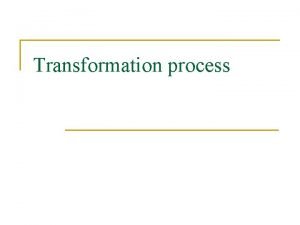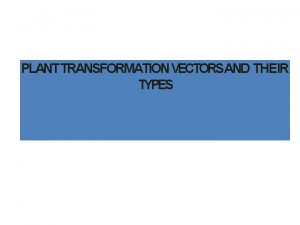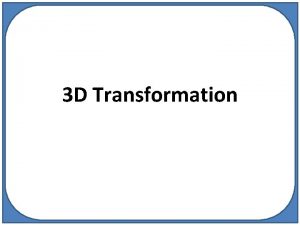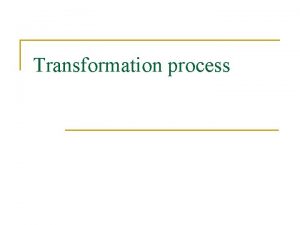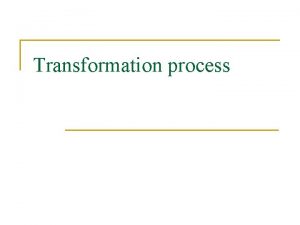The Journey to Transformation Whole Health Clinical Care








































- Slides: 40

The Journey to Transformation Whole Health Clinical Care Symposium Face-to-Face Course Welcome to Day 3! 0

19. Revisiting Your Aim: New Lenses The Journey to Transformation 1

Revisiting the Circle of Health Consider and care for the whole person Practice across teams and over time Equip using a broad range of resources and support Continue to provide excellent clinical care Actively use foundational skills (communication, relationship building and MI) Connect with MAP Set shared goals that link to MAP

Back to ADKAR

How’s Confidence at This Point? On a scale from 1 to 10, how confident are you that you can make some changes in this area?

20. Element 4: Coaching The Journey to Transformation 5

The Lucky 7: 7 Elements to Address Barriers - Coaching 1. Communication 2. Sponsorship 3. Resistance Management 4. Coaching 5. Nuts and Bolts 6. Training 7. Circling Back

Coaching: Overview Intended Outcomes: Awareness/Desire/Knowledge/Ability/Reinforcement The Key Question: How can you support managers and supervisors with making a change? Possibilities • Ensure that the necessary sponsorship and communication activities are in place and visible to managers and supervisors • Prepare them to lead change with their employees • Enable them to introduce, manage and reinforce change • Build awareness of how a change impacts a given employee and WIIFM 7

Coaching: Overview Intended Outcomes: Awareness/Desire/Knowledge/Ability/Reinforcement (Continued) More Possibilities • Create desire through personal interactions and the effective management of resistance • Develop knowledge through on-the-job training and mentoring • Foster ability by creating the right environment for employees to develop new skills and behaviors Other thoughts? 8

Coaching Plan: Considerations The influence that a supervisor or manager has on front-line employees is significant and will directly impact the overall engagement of employees in the change process. Your coaching plan defines: • How your team will support managers and supervisors during the change • How they will interact with front-line employees Your role is to fully enable these managers and supervisors to: • Fulfill their role as effective change management coaches • Manage change with their employees during the transition • Reinforce change with their employees in the new, changed environment 9

Partner Exercise: Coaching Tips • Pair up with someone from another team • Together, list 5 helpful tips that can support managers and supervisors with supporting changes • We’ll generate a list!

Group Activity: Coaching Your Colleagues 1. Complete the Coaching section of your Power. Point presentation 2. You can refer to the Prosci® Coaching Plan Template in your workbook as well and use as you see fit 11

WHCC Coaching Adapted from: Prosci

21. Element 5: Nuts and Bolts The Journey to Transformation 13

The Lucky 7: 7 Elements to Address Barriers – Nuts and Bolts 1. Communication 2. Sponsorship 3. Resistance Management 4. Coaching 5. Nuts and Bolts 6. Training 7. Circling Back

Nuts and Bolts: Overview Intended Outcomes: Relevant Across All Areas of ADKAR! As a small group, discuss: 1. How does documentation fit in to your plan? 2. How do coding and tracking fit in? 3. What other details (logistics, paperwork, etc. ) need to be addressed? No Workbook Section this time! 15

Nuts and Bolts: Tips Q&A Time: Documentation Q&A Time: Tracking and Coding How do I. . ? 16

Group Activity: Nuts and Bolts 1. Complete the Nuts and Bolts section of your Power. Point presentation 2. Really try to anticipate any additional details you might need to consider 17

WHCC Nuts and Bolts Adapted from: Prosci

22. Element 6: Training The Journey to Transformation 19

The Lucky 7: 7 Elements to Address Barriers - Training 1. Communication 2. Sponsorship 3. Resistance Management 4. Coaching 5. Nuts and Bolts 6. Training 7. Circling Back

Training: Tips Intended Outcomes: Knowledge/Ability • Make sure you cover Awareness and Desire, before you jump to training! • If not, you end up with a class full of angry, voluntold people • What other consequences have you seen? • Some more resistant providers might prefer more advanced clinical course experiences • Add to time people already have set aside like grand rounds, morning huddles, or staff meetings • Make use of others at your sites - like NWECs or FECs - to help you strategize 21

Training: Overview Intended Outcomes: Knowledge/Ability • Identify different audiences who require training • Conduct a needs assessment for each group to pinpoint knowledge and skill gaps • Target specific audiences and build the knowledge, skills and behaviors they need both during and after the change • Document training requirements based on the current state versus the future state 22

Considerations Desired Outcomes: Knowledge/Ability • Start with your objectives. What knowledge and ability gaps are you wanting to fill? • Consider different forms of training, but don’t get hung up on particular courses • OPCC&CT Live Courses • Pre-created Half-day, 1 -hour • Online: TMS, Share. Point resources, Whole Health Library, www. va. gov/wholehealth • Courses specific to your site (e. g. , CPRS, CIH resources, clinic flow) • Other materials, such as M. I. , HPDP materials, Veteran Handouts

Group Activity: Training 1. Complete the Training section of your Power. Point presentation 2. Focus on objectives and gaps, not specific courses 3. Check in with faculty if you have any questions regarding any of the Whole Health educational offerings 24 Faculty will circulate to help out

WHCC Training Plan Adapted from: Prosci

Large Group Discussion Training Debrief 26

23. Element 7: Circling Back The Journey to Transformation 27

The Lucky 7: 7 Elements to Address Barriers – Circling Back 1. Communication 2. Sponsorship 3. Resistance Management 4. Coaching 5. Nuts and Bolts 6. Training 7. Circling Back

Prosci 3 -Phase Change Management Process ® A structured process for managing the ‘people side’ of change on a project or initiative 29

Circling Back: Overview Several Elements Involved • Collect and analyze feedback • Diagnose gaps and manage resistance • Take corrective action • Celebrate Success Let’s explore each one some more. . . Image Credit: Michigan. gov 30

Circling Back: Collect and Analyze Feedback • Listen to employees and gather feedback • Audit compliance with new process, systems and job roles • Analyze the effectiveness of your change management activities 31

Circling Back : Diagnose Gaps and Manage Resistance • Diagnosing gaps and managing resistance is an ongoing process • This step requires close relationships with the primary sponsor and key stakeholders • Front line supervisors also play a key role in managing resistance • Determine the root cause of resistance • Develop plans to address these root causes • Prepare sponsors and coaches to manage resistance 32

Take Corrective Action and Celebrate Success • Implement corrective actions if you notice problems • Celebrate successes and reinforce the change • Conduct after-action reviews and transfer ownership of the change to operational managers 33

Tips On Celebration and Reinforcement 1 • Constantly seek out evidence of progress in the project • Watch for the achievement of major milestones and identify early successes even if small • Organize ways to recognize groups and individuals who have achieved success. Make it public 34

Tips On Celebration and Reinforcement 2 • Use normal staff meetings or regularly scheduled department meetings as an avenue for recognition of achievement • Ensure that key stakeholders are aware of these achievements and involve managers in the chain of command to award these recognitions • Use the communications plan guidelines to develop success celebration communications 35

Group Activity: Circling Back 1. Complete the Circling Back section of your Power. Point presentation 2. Are there other aspects of your plan you will want/need to revisit over time? No Workbook Section this time! 36

WHCC: Circling Back Adapted from: Prosci

Large Group Discussion Circling Back 38

This Concludes our Time with the 7 Elements 1. Communication 2. Sponsorship 3. Resistance Management 4. Coaching 5. Nuts and Bolts 6. Training 7. Circling Back Any comments or questions?
 Whole school whole community whole child model
Whole school whole community whole child model Whole health clinical group
Whole health clinical group Hip fracture care clinical care standard
Hip fracture care clinical care standard Whole health circle of health
Whole health circle of health Massed practice
Massed practice The whole journey
The whole journey Types of care primary secondary tertiary
Types of care primary secondary tertiary Care value base health and social care
Care value base health and social care Clinical systems transformation
Clinical systems transformation Health and social care component 3
Health and social care component 3 Clemens hong
Clemens hong Whole systems integrated care
Whole systems integrated care Live your whole life trinity
Live your whole life trinity Whole health library
Whole health library Passport to whole health
Passport to whole health Hypothalamex
Hypothalamex Administrative information systems definition
Administrative information systems definition Hát kết hợp bộ gõ cơ thể
Hát kết hợp bộ gõ cơ thể Ng-html
Ng-html Bổ thể
Bổ thể Tỉ lệ cơ thể trẻ em
Tỉ lệ cơ thể trẻ em Gấu đi như thế nào
Gấu đi như thế nào Glasgow thang điểm
Glasgow thang điểm Hát lên người ơi
Hát lên người ơi Kể tên các môn thể thao
Kể tên các môn thể thao Thế nào là hệ số cao nhất
Thế nào là hệ số cao nhất Các châu lục và đại dương trên thế giới
Các châu lục và đại dương trên thế giới Công của trọng lực
Công của trọng lực Trời xanh đây là của chúng ta thể thơ
Trời xanh đây là của chúng ta thể thơ Mật thư anh em như thể tay chân
Mật thư anh em như thể tay chân Làm thế nào để 102-1=99
Làm thế nào để 102-1=99 Phản ứng thế ankan
Phản ứng thế ankan Các châu lục và đại dương trên thế giới
Các châu lục và đại dương trên thế giới Thơ thất ngôn tứ tuyệt đường luật
Thơ thất ngôn tứ tuyệt đường luật Quá trình desamine hóa có thể tạo ra
Quá trình desamine hóa có thể tạo ra Một số thể thơ truyền thống
Một số thể thơ truyền thống Cái miệng xinh xinh thế chỉ nói điều hay thôi
Cái miệng xinh xinh thế chỉ nói điều hay thôi Vẽ hình chiếu vuông góc của vật thể sau
Vẽ hình chiếu vuông góc của vật thể sau Thế nào là sự mỏi cơ
Thế nào là sự mỏi cơ đặc điểm cơ thể của người tối cổ
đặc điểm cơ thể của người tối cổ Thế nào là giọng cùng tên
Thế nào là giọng cùng tên
